BMW HP4 Race vs. BMW S 1000 RR: COMPARISON TEST
| November 15, 2017
Nội Dung Chính
We Know It’s Good, But How Good?
We put BMW’s carbon-dressed HP4 superbike head-to-head against BMW’s own S1000RR to find out.
 The S 1000 RR (right) meets the HP4 Race. It’s like the S 1000 RR hit the gym like mad for a year!
The S 1000 RR (right) meets the HP4 Race. It’s like the S 1000 RR hit the gym like mad for a year!
Every second feels like an hour. My eyes are locked on BMW’s technicians, but they aren’t in a rush. They take their time making final preparations, running through checklists, and splashing the last bit of fuel in the tank. The gas cap is screwed on, the starter button activated, and the engine fired. They then turn to me with a look suggesting, “Are you ready yet?” Yeah, as if I’m the one to be waiting on.
As I swing a leg over the motorcycle, I feel my heart rate spike and my muscles tense. This rarely happens to me. I make my way around the first few bends of the Circuit of The Americas, trying relentlessly to relax. At some point, I let out a sigh of relief, mumbling “I’ve got this.” That moment was short-lived.
The instant I hit the back straightaway, all hell broke loose. I’m slammed against the tail section, fighting to hold onto the handlebars as I click through the gearbox. Fourth. Fifth. Wheelie. Sixth. My vision is blurred. I grab the brakes, getting my weight thrown to the front of the bike and slowed down for the hard left at the end. My heart rate is at its max.
This is what an adrenaline rush feels like on the BMW HP4 Race.
Click here to read this in the Cycle News Digital Edition Magazine.
By Michael Gilbert
Photography Jon Beck
The BMW HP4 Race is anything but an ordinary literbike, nor is it a special homologation model that BMW Motorrad is using to push the boundaries in the World Superbike Championship. It’s more than that. With the HP4 Race, BMW is expanding beyond any rules package and building what it says is the best motorcycle it can produce. A motorcycle it built, simply because it can.
The marvel of the HP4 Race begins with its twin-spar carbon-fiber frame, which is built with the same Resin Transfer Molding process used on BMW’s i3 electric car. The specialized process allows for the frame to be constructed with a single piece of carbon fiber rather than layered segments that can alter the consistency of construction from frame to frame.
The wheels and subframe are also made of carbon fiber, ultimately bringing the HP4’s weight down to a mere 378 pounds while fully fueled. Just for reference, a bone-stock S 1000 RR weighs 459 pounds, and the minimum weight for a World Superbike machine is 370 pounds (with an empty tank). Pair that with its 215-horsepower engine, and what you have is more missile than motorcycle.
To up the ante, BMW dressed the HP4 Race head-to-toe in top-shelf racing parts, the same parts that, up until now, only high-level race teams had access to. A set of Öhlins FGR300 front forks with titanium-nitride-coated inner tubes and an Öhlins TTX36 rear shock handle the job of smoothing out the HP4’s ride, while a Suter-made swingarm is used to offer supreme rear traction while the bike is at full lean. In case that weren’t enough, add in the nickel-plated Brembo GP4PR monoblock front brake calipers (the same used in MotoGP) with titanium anti-friction pistons and the 2D dashboard perched behind the handlebars, which will grab your attention and never let it go. I promise.
 The BMW HP4 Race is extremely agile getting in and out of the corners thanks to its featherweight 378-pound build.
The BMW HP4 Race is extremely agile getting in and out of the corners thanks to its featherweight 378-pound build.
Thrashing The Best
BMW invited select U.S. media outlets to test the HP4 Race at the Circuit of The Americas in conjunction with the Double R Festival where we flogged S 1000 RRs around the 3.4-mile, 20-turn circuit.
Having already completed a full test of the HP4 (click here to check it out) we decided to put the “standard” S 1000 RR into a grudge match with BMW’s full-carbon superbike. A quick look at the spec sheets will tell you which bike has more racetrack prowess, but how does the extra performance of the HP4 Race feel in comparison to the S 1000 RR?
Opening the throttle on the HP4 to drive onto COTA’s back straightaway will remind you exactly why it’s dubbed a superbike. Throttle response is direct, but not so direct that it makes the motorcycle unrideable. In fact, the initial power delivery is linear and forgiving, giving you the confidence to twist the throttle on corner exit and not worry about being spat off. Race bikes have to be aggressive enough to produce quick lap times, but gentle enough to allow mere mortals (with all our flaws and limitations) to still manage them over the course of a race. Through years of racing, BMW has perfected that balance. And the HP4 Race is proof.
It isn’t docile though. As the revs pass the 10,000 rpm mark, the HP4 transforms into a full-blown rocket ship. It accelerates with (mildly) controlled anger, forcing your eyeballs to the back of their sockets as it wheelies toward its redline of 14,500 rpm (300 rpm higher than the S 1000 RR). There’s no time to relax on the straightaways; snap your fingers and you’ll be slamming on the brakes for the next corner.
 Power delivery of the HP4’s 215-horsepower engine isn’t what you’d think. It’s soft off the bottom, then takes life as you hit the center portion of the tire.
Power delivery of the HP4’s 215-horsepower engine isn’t what you’d think. It’s soft off the bottom, then takes life as you hit the center portion of the tire.
Like the HP4, the S 1000 RR’s power delivery is soft off the bottom, although the throttle doesn’t feel as connected to the rear wheel. A near quarter throttle turn is required for the S 1000 RR to begin driving forward, but once it starts rolling, it isn’t any slouch. There’s a hit in the powerband at around 10,500 rpm, but the quickshifter’s overly intrusive ignition cut hinders the true potential of the S 1000 RR by slowing it down in between each gear. Comparing top-end speeds between the two bikes is almost useless; the HP4 will be light years ahead of the S 1000 RR by the end of the straightaway.
Much of the HP4’s forgiving nature is the result of its advanced 15-level traction control system, which works impressively well to keep the bike in line under acceleration. Like any race bike, the TC feature on the upper-spec BMW gives the rider the ability to drive forward off the corner without being held back. That’s the opposite of the S 1000 RR’s package, which acts as a safety net for overly aggressive riders. The auto-blip downshifter on the HP4 is far more superior as well, feeling seamless even under hard deceleration. The S 1000 RR’s unit is inconsistent, often hitting false neutrals while backshifting to first gear.
The biggest difference between the two motorcycles though has to do with their respective handling qualities. The S 1000 RR is known for being relatively light on its feet and quick to turn into the corner, but the HP4 takes it to the next level. The extremely low weight and carbon fiber wheels of the HP4—which are said to reduce gyroscopic force by 40 percent—make it a lethal weapon through tip-toe-speed side-to-side transitions and corner entries. The stability only adds to the experience, allowing you to throw your weight from side to side without the motorcycle becoming unsettled. Feel from the rear end is remarkable, too; the Suter-made superbike swingarm offers mind-blowing amounts of traction, and lets you know exactly what’s going on beneath you.
 The S1000RR is by no means a slow motorcycle! Wheelies exiting COTA’s final turn were common during our day.
The S1000RR is by no means a slow motorcycle! Wheelies exiting COTA’s final turn were common during our day.
The S 1000 RR struggles in the stability department by comparison. Put too much input into its chassis and the bike starts to feel unnerving, wallowing as it fights to settle down.
Likewise, suspension components on each bike feel like they’ve come from two separate worlds. And they have. It’s important to remember that the S 1000 RR is built to be a street bike; comfortable for daily riding, but aggressive enough to handle spirited days on the track or in the canyons. That said, baseline suspension settings are soft, the front and rear bits often blowing through their travel under heavy loads such as hard braking or acceleration. The racing-spec Öhlins bits on the HP4 are stiff, but not so much as to make the ride harsh. The fork and shock both provide ample amounts of feel and support, especially as lap times begin dropping. Finding a fault in the HP4’s setup is a hard task.
It’s funny how the HP4 Race’s brakes are extremely easy to use; you’d think that superbike-spec Brembo Monoblocks would want to throw you over the handlebars every chance they got. Instead, the initial bite is gentle, and stopping force builds in a very linear fashion. It’s not uncommon to use the same brake markers as you would on the S 1000 RR because, even with the extra speed from the superbike engine, the outright power of the brakes will stop you on a dime.
 For being a “standard” literbike, the BMW S1000RR has a high level of racetrack prowess. The inline-four is quick and its chassis is lively, resulting in a high fun factor.
For being a “standard” literbike, the BMW S1000RR has a high level of racetrack prowess. The inline-four is quick and its chassis is lively, resulting in a high fun factor.
What A Bike
For years, BMW’s S 1000 RR has sat near the pointy end of the literbike spectrum. New bikes have come. Old bikes have gone. But through a solid chassis and monster power, the S 1000 RR always stayed. A true force to be reckoned with, and one most of us will never really get to push within 20 percent of its full potential.
But then there’s the HP4 Race. And sure, it’s obvious that this latest iteration of “BMW best” was going to push its little brother to the side. But could we really have expected the gap to be this much?
We probably should have.
BMW has poured its very best resources and a lot of time into creating the carbon-dressed HP4 Race, and in the end created a motorcycle that’s not only a work of art, but a demon on the racetrack. If you can find the chance to ride one—and get past drooling over the eye-candy bolted all over it—you’d probably agree that it’s the best track bike money can buy. It’s a monster, and yet somehow forgiving and fun.
Would I buy one? In a heartbeat. That is of course if I could somehow scrounge together enough money for the $78,000 price tag. The BMW HP4 is the next best thing to a full-factory superbike, and the ultimate track weapon. A sum more than its parts, and an absolute steal if you consider what you’re getting for the money – performance-wise.
No need to mention the adrenaline rush that comes with.CN
What’s under the skin?
The BMW HP4 Race is a technical marvel. Here is all of its eye candy that we can’t get our eyes off of:
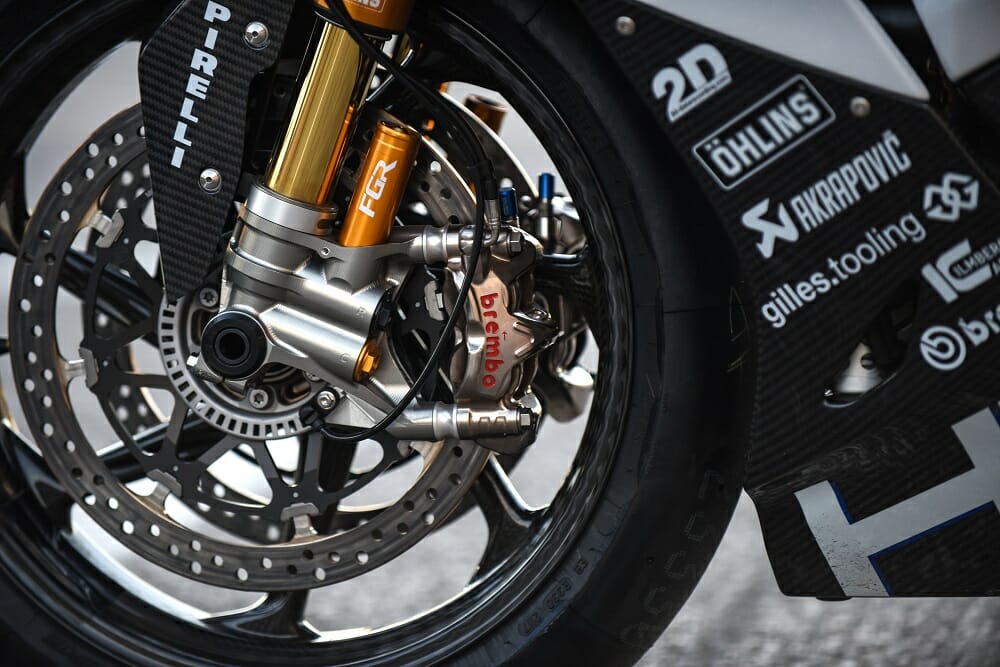
BMW outfitted the HP4 Race with the same Brembo GP4PR monoblock brake calipers that world-level racing teams use. Outright braking power is incredible, yet a gentle initial bite makes them easy to use.
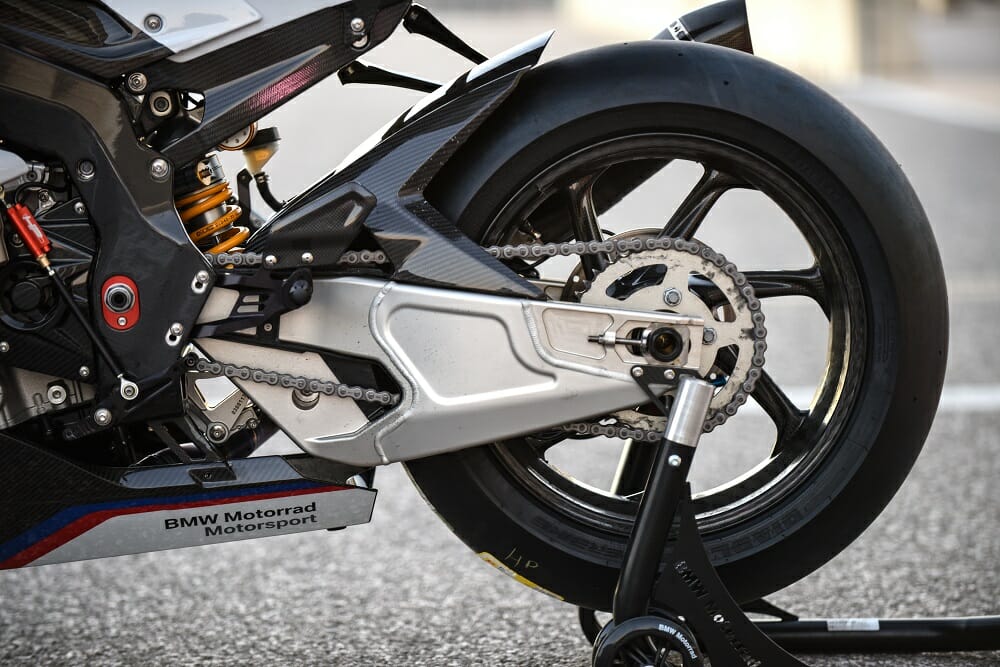
An ultra-stiff swingarm developed by Suter boosts rear grip at maximum lean angle, but also offers tons of feel to understand what the motorcycle is doing beneath you.
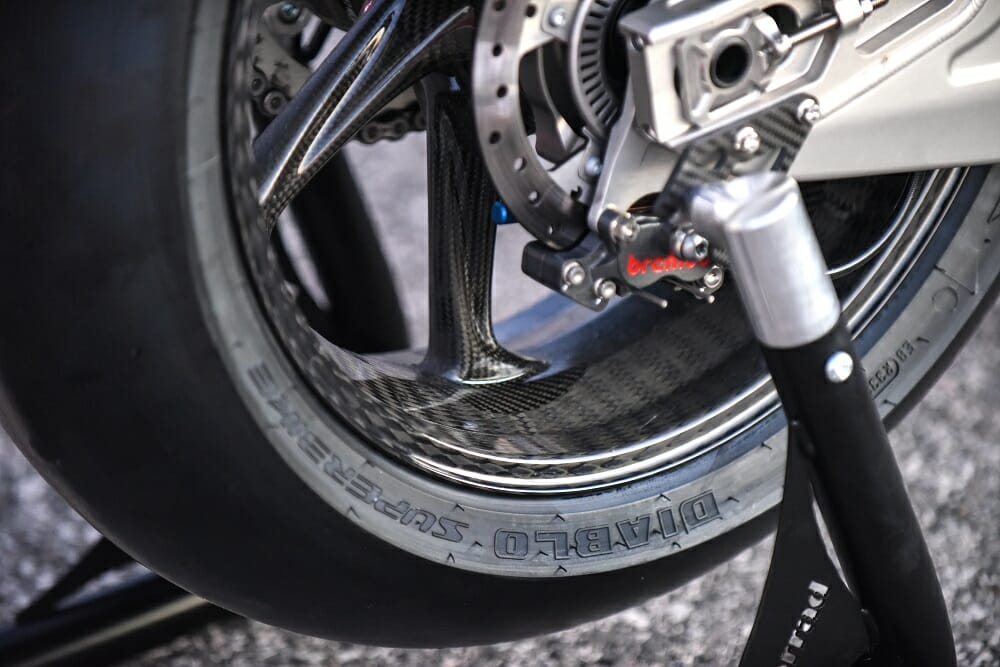
The carbon-fiber wheels used on the HP4 Race are said to reduce gyroscopic force by 40 percent, greatly improving agility during side-to-side transitions.
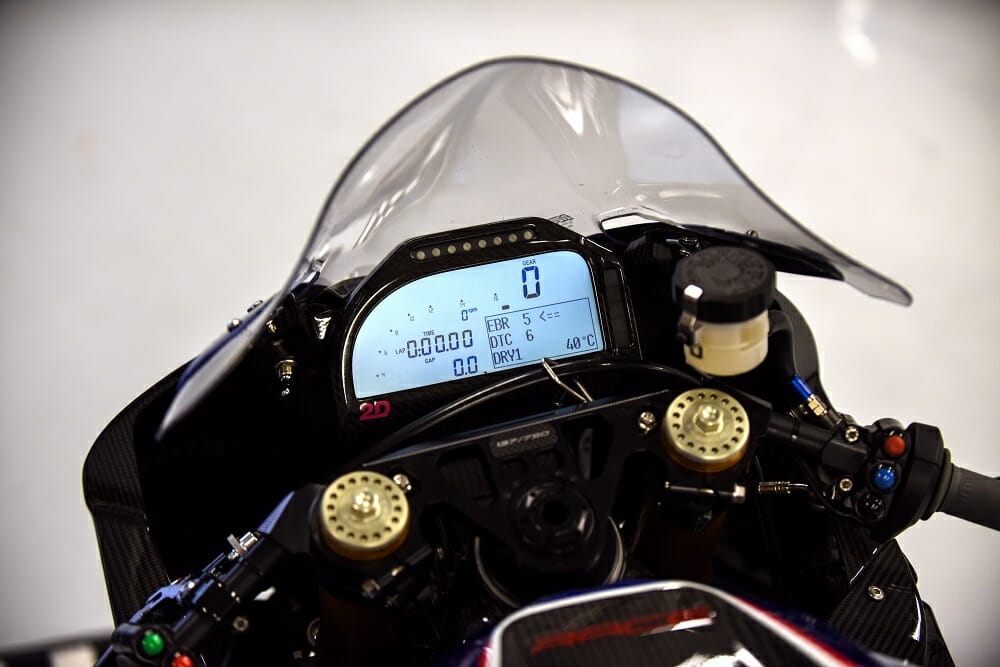
A 2D dashboard offers the rider vital information that is easily legible even at full speed.
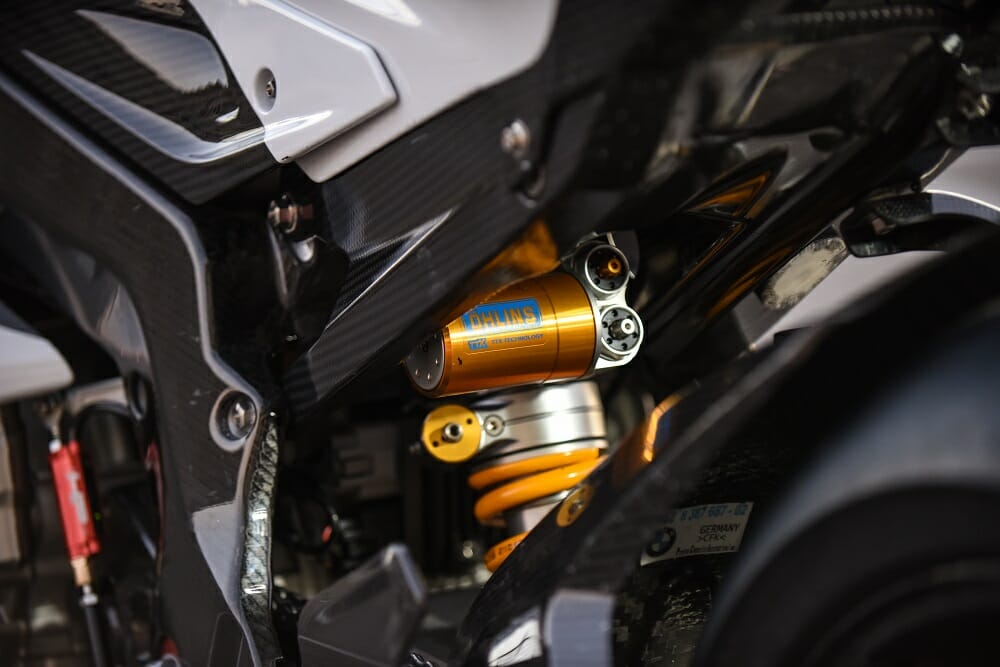
Öhlins suspension bits are fitted to the front and rear of the HP4 Race, including this TTX36 rear shock. The top-shelf suspension offers impressive feel and support, without being teeth-chattering stiff.
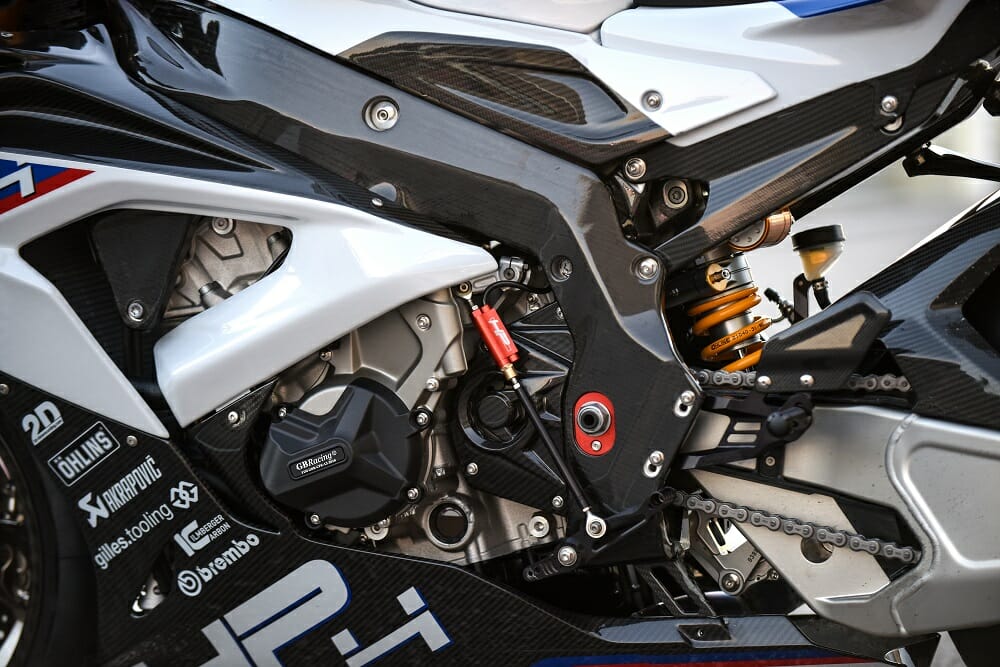
The heart of the BMW HP4 Race is a highly modified S 1000 RR engine, which is claimed to produce 215 horsepower. The top-end power is intense, but the power delivery is smooth enough to handle over race distance.
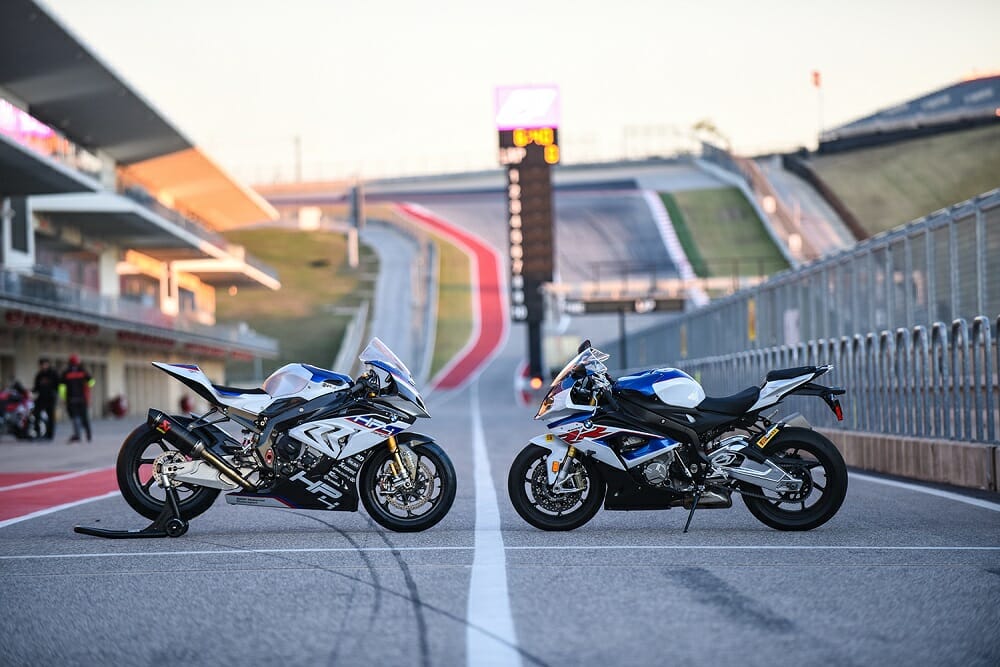
SPECIFICATIONS
BMW S 1000 RR ($23,990) / BMW HP4 Race ($78,000)
Engine:
Liquid-cooled, DOHC, inline 4-cylinder engine, four valves per cylinder, double overhead camshafts / Liquid-cooled, DOHC, inline 4-cylinder, 4-valves-per cylinder
Displacement:
999cc / 999cc
Bore x stroke:
80 x 49.7mm / 80 x 49.7mm
Compression ratio:
13:1 / 13.9:1
Clutch:
Wet multi-plate / Wet multi-plate, anti-hopping
Transmission:
Six-speed / Six-speed
Chassis:
Aluminum bridge-type frame with load-bearing engine / Carbon-fiber, monocoque RTM frame w/adjustable steering-head angle
Front suspension:
46mm inverted fork, fully adjustable / Ohlins, FGR 300 Superbike World Cup, fully adjustable
Rear suspension:
Monoshock, fully adjustable / Aluminum underslung double-sided swingarm, Ohlins TTX36 GP single shock, fully adjustable
Front brake:
320mm dual floating discs, radially-mounted dual monobloc Brembo four-piston calipers, ABS as standard / Brembo Racing twin disc, 320mm, 4-piston
Rear brake:
220mm disc, single-piston caliper, ABS as standard / Brembo Racing single disc, 220mm, 4-piston Superbike World Cup fixed
Front tire:
120/70 ZR 17 / 120/70 ZR 17 Pirelli Diablo Superbike Slick SC2
Rear tire:
190/55 ZR17 / 200/60 ZR 17 Pirelli Diablo Superbike Slick SC2
Seat height:
32.1-33.5 in. / 32.1-33.3 in
Fuel capacity:
4.6 gal / 4.6 gal.
Weight:
439 lbs. (curb, claimed) / 322 lbs. (dry)
Click here to read this in the Cycle News Digital Edition Magazine.
Share this:
-
Share






